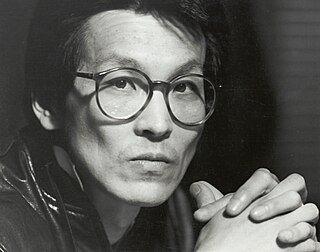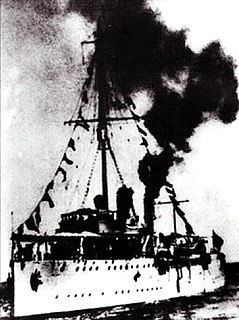
Chiang Kai-shek, also known as Generalissimo Chiang or Chiang Chungcheng and romanized as Chiang Chieh-shih or Jiang Jieshi, was a Chinese politician and military leader who served as the leader of the Republic of China between 1928 and 1975, first in mainland China until 1949 and then in Taiwan until his death. He was recognized by much of the world as the head of the legitimate government of China until 1971, during which the United Nations passed Resolution 2758.

The Kuomintang of China is a major political party in the Republic of China on Taiwan, based in Taipei, that was founded in 1911, and is currently an opposition political party in the Legislative Yuan.

Wang Jingwei, born as Wang Zhaoming, but widely known by his pen name "Jingwei", was a Chinese politician. He was initially a member of the left wing of the Kuomintang (KMT), leading a government in Wuhan in opposition to the right wing government, but later became increasingly anti-communist after his efforts to collaborate with the Chinese Communist Party (CCP) ended in political failure. His political orientation veered sharply to the right later in his career after he collaborated with the Japanese.

Wayne Wang is a Hong Kong–born American film director.

Chiang Hsiao-yen or John Chiang, formerly surnamed Chang, is a Taiwanese politician affiliated with the Kuomintang. He is the grandson of Chiang Kai-shek, former leader of the Republic of China.

The Wang Jingwei regime is the common name of the Reorganized National Government of the Republic of China, a puppet state of the Empire of Japan, located in eastern China. This should not be confused with the Republic of China under Chiang Kai-shek, which was a separate, non-Japanese government. It was ruled by a one-party totalitarian dictatorship under Wang Jingwei, an ex-Kuomintang (KMT) official. The region that it would administer was initially seized by Japan throughout the late 1930s with the beginning of the Second Sino-Japanese War. Wang, a rival of Chiang Kai-shek and member of the pro-peace faction of the KMT, defected to the Japanese side and formed a collaborationist government in occupied Nanjing in 1940. The new state claimed the entirety of China during its existence, portraying itself as the legitimate inheritors of the Xinhai Revolution and Sun Yat-sen's legacy as opposed to Chiang Kai-shek's government in Chongqing, but effectively only Japanese-occupied territory was under its direct control. Its international recognition was limited to other members of the Anti-Comintern Pact, which it was a signatory of. The Reorganized National Government existed until the end of World War II and the surrender of Japan in August 1945, at which point the regime was dissolved and many of its leading members were executed for treason.

He Yingqin, also Ho Ying-chin, was one of the most senior generals of the Kuomintang (KMT) during Republic of China, and a close ally of Chiang Kai-shek.

The Central Plains War was a series of military campaigns in 1929 and 1930 that constituted a Chinese civil war between the Nationalist Kuomintang government in Nanjing led by Generalissimo Chiang Kai-shek and several regional military commanders and warlords that were former allies of Chiang.
The Shanghai massacre of April 12, 1927, known commonly in China as the April 12 Purge or April 12 Incident, was the violent suppression of Communist Party of China (CPC) organizations in Shanghai by the military forces of Generalissimo Chiang Kai-shek and conservative factions in the Kuomintang. Following the incident, conservative KMT elements carried out a full-scale purge of Communists in all areas under their control, and even more violent suppression occurred in Guangzhou and Changsha. The purge led to an open split between left and right wing factions in the KMT, with Chiang Kai-shek establishing himself as the leader of the right wing faction based in Nanjing, in opposition to the original left-wing KMT government based in Wuhan led by Wang Jingwei.

The Canton Coup of 20 March 1926, also known as the Zhongshan Incident or the March 20th Incident, was a purge of Communist elements of the Nationalist army in Guangzhou undertaken by Chiang Kai-shek. The incident solidified Chiang's power immediately before the successful Northern Expedition, turning him into the paramount leader of the country.
The Yunnan–Guangxi War was a war of succession fought for control of the Chinese Nationalist Party after the death of Sun Yat-sen in 1925. It was launched by the Yunnan clique against the party leadership and the New Guangxi clique.
Events in the year 1947 in the Republic of China. This year is numbered Minguo 36 according to the official Republic of China calendar.
Events from the year 1974 in Taiwan, Republic of China. This year is numbered Minguo 63 according to the official Republic of China calendar.
Uraecha is a genus of longhorn beetles of the subfamily Lamiinae, containing the following species:
Mao Zedong is a 2013 Chinese epic biographical television series which dramatises the life of Mao Zedong, the father of the People's Republic of China. it was directed by Gao Xixi, and starring Tang Guoqiang, Liu Jing, Guo Lianwen, and Wang Wufu. The television series is released in 2013 to mark the 120th anniversary of the birth of Mao Zedong.
Nedine sparatis is a species of beetle in the family Cerambycidae. It was described by Wang and Chiang in 1999.
Nedine subspinosa is a species of beetle in the family Cerambycidae. It was described by Wang and Chiang in 1999.

The Wuhan nationalist government, also known as the Wuhan government, Wuhan regime, or Hankow government, was a left-wing nationalist government of China led first by Eugene Chen, and later by Wang Jingwei, that was based in Wuhan from 5 December 1926 to 21 September 1927. Following the capture of Wuhan during the Northern Expedition, the existing Kuomintang (KMT) government, which had been based in Guangzhou, moved there in December 1926. In April 1927, after National Revolutionary Army (NRA) commander-in-chief Chiang Kai-shek purged communists and leftists in the "Shanghai massacre", the Wuhan government split from Chiang in what is known as the "Nanjing–Wuhan split". Chiang subsequently formed his own government in Nanjing. While Chiang continued the Northern Expedition on his own, increasing tensions between communists and the KMT in the Wuhan government resulted in a new purge of communists from that government, and an eventual reconciliation with the Nanjing faction, after which the government moved to Nanjing.











